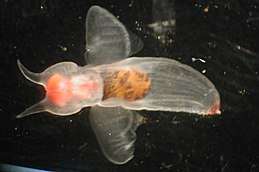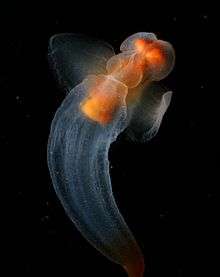Clione limacina
Clione limacina, known as the naked sea butterfly, sea angel, and common clione, is a sea angel (pelagic sea slug) found from the surface to greater than 500 m (1,600 ft) depth.[2][3] It lives in the Arctic Ocean and cold regions of the North Atlantic Ocean. It was first described by Friderich Martens in 1676 and became the first gymnosomatous (without a shell) "pteropod" to be described.[4]
| Clione limacina | |
|---|---|
 | |
| Clione limacina | |
| Scientific classification | |
| Kingdom: | |
| Phylum: | |
| Class: | |
| (unranked): | |
| Superfamily: | |
| Family: | |
| Subfamily: | Clioninae |
| Genus: | |
| Species: | C. limacina |
| Binomial name | |
| Clione limacina | |
| Synonyms[2] | |
| |
Subspecies
Distribution
Clione limacina is found in cold waters of the Arctic Ocean and North Atlantic Ocean, ranging south at least to the Sargasso Sea.[6][7] There are three other species in the genus, which formerly were included in C. limacina (either as subspecies, variants or subpopulations). These are C. elegantissima of the cold North Pacific (at least north to the Gulf of Alaska; the Beaufort Sea is inhabited by C. limacina), C. okhotensis of the Okhotsk Sea (where it overlaps with C. elegantissima), and C. antarctica of Antarctic waters.[7]

Description
There are two subspecies that differentiate in body length.[8] The northern subspecies lives in colder water, matures at 3 cm (1.2 in) and can reach a size of 7–8.5 cm (2.8–3.3 in).[8][9] This makes it by far the largest sea angel.[7] In comparison, the size of the southern subspecies is 1.2 cm (0.5 in),[8] C. elegantissima is up to 3 cm (1.2 in), C. okhotensis up to 0.8 cm (0.3 in),[7] and C. antarctica up to 3 cm (1.2 in).[10]
The neurobiology of this pteropod has been studied in detail.
Ecology
Clione limacina inhabits both the epipelagic and mesopelagic regions of the water column.[5]
Feeding habits
Adults feed in a predator-prey relationship almost exclusively on the sea butterflies of the genus Limacina: on Limacina helicina and on Limacina retroversa.[3][8] The feeding process of Clione limacina is somewhat extraordinary. The buccal ("mouth") apparatus consists of three pairs of buccal cones. These tentacles grab the shell of Limacina helicina. When the prey is in the right position, with its shell opening facing the radula of Clione limacina, it then grasps the prey with its chitinous hooks, everted from hook sacs. Then it extracts the body completely out of its shell and swallows it whole.[11][12]
Adult Limacina are absent for much of the year, leaving C. limacina without access to their main food source. A study of 138 C. limacina during a period without adult Limacina found that the stomachs of 24 contained remains of amphipods and 3 contained remains of calanoids.[9] This temporary prey change may allow them to survive in periods of starvation,[9] although the species can survive for one year without food.[13] Under such exceptional starvation in the laboratory the length of slugs have decreased on average from 22.4 to 12 mm (0.88 to 0.47 in).[13]
The earliest larvae stages of C. limacina feed on phytoplankton, but from the later laval stage this changes to Limacina.[9] The development of these two species is parallel and small C. limacina feed on Limacina of a similar size, while large C. limacina avoid small Limacina (including its larvae).[9]
Life cycle
In Svalbard, the life cycle of C. limacina appears to be at least 2 years.[8] It is a hermaphrodite and observations suggest this is simultaneous.[9] It breeds during the spring and summer, and the eggs are about 0.12 mm (4.7 thou).[9]
Clione limacina is a prey of planktonic feeders, such as the baleen whales,[8] which historically led to sailors naming it "whale-food".[14] Some fishes are also its predators.[8] For example, the Chum Salmon, Oncorhynchus keta, is a major predator of sea angels.[15]
References
This article incorporates CC-BY-SA-3.0 text from the reference [5]
- Phipps, C.J., 1774. A voyage towards the North Pole undertaken by His Majesty's Command 1773 : i–viii, 1–253
- Gofas, S. (2012). Clione limacina. Accessed through: World Register of Marine Species at http://www.marinespecies.org/aphia.php?p=taxdetails&id=139178 on 2012-07-23
- Lalli C. M. & Gilmer R. W. (1989). Pelagic Snails. The biology of holoplanktonic gastropod molluscs. Stanford University Press: Stanford, California. page 188.
- Spitzbergiscbe oder grönlandische Reisebeschreibung, p. 189, p1. P. fig. f.
- Gofas, S. (2011). Clione limacina. Accessed through: World Register of Marine Species at http://www.marinespecies.org/aphia.php?p=taxdetails&id=139178 on 2011-01-29
- Mileikovsky S.A. (1970) Breeding and larval distribution of the pteropod Clione limacina in the North Atlantic, Subarctic and North Pacific Oceans. Marine Biology 6(4): 317–334.
- Yamazaki, Tomoyasu; Kuwahara, Takashi (2017). "A new species of Clione distinguished from sympatric C. limacina (Gastropoda: Gymnosomata) in the southern Okhotsk Sea, Japan, with remarks on the taxonomy of the genus". Journal of Molluscan Studies. 83 (1): 19–26. doi:10.1093/mollus/eyw032. ISSN 0260-1230.
- Böer M., Gannefors C., Kattner G., Graeve M., Hop H. & Falk-Petersen S. (2005). "The Arctic pteropod Clione limacina: seasonal lipid dynamics and life-strategy". Marine Biology 147(3): 707–717. doi:10.1007/s00227-005-1607-8.
- Kallevik, I.H.F. (2013). Alternative prey choice in the pteropod Clione limacina (Gastropoda) studied by DNA-based methods. Archived 2016-03-04 at the Wayback Machine Biology Field of study - Arctic Marine Ecology and Resource Biology. Bio-3950 (60 ECT). The University Center in Svalbard.
- McClintock, J.B.; B.J. Baker, eds. (1997). Marine Chemical Ecology. CRC Press. p. 215. ISBN 0-8493-9064-8.
- Hermans C. O. & Satterlie R. A. (1992). "Fast-strike feeding behavior in a pteropod mollusk, Clione limacina Phipps". The Biological Bulletin, Marine Biological Laboratory, 182: 1–7.
- Vortsepneva, E.V.; Tzetlin, A.B (March 2014). "New Data on the Fine Structure of hooks in Clione limacina (Gastropoda, Opistobranchia) and Diversity of the Jaw Apparatus in Gastropods". Zoologicheskii Zhurnal. 93 (3): 466–478. doi:10.7868/S0044513414030179. Retrieved 1 May 2015.
- Böer M., Graeve M. & Kattner G. (2006). "Exceptional long-term starvation ability and sites of lipid storage of the Arctic pteropod Clione limacina". Polar Biology 30(5): 571–580. doi:10.1007/s00300-006-0214-6.
- Gosse, Philip Henry (1854). Mollusca. Natural History. Society for Promoting Christian Knowledge. p. 72.
- Takashi, Makoa; Takashi, Kuwahara; Masanoa, Narita (March 2014). "Carotenoids of Sea Angels Clione limacina and Paedoclione doliiformis from the Perspective of the Food Chain". Marine Drugs. 12 (3): 1460–1470. doi:10.3390/md12031460. PMC 3967221. PMID 24633249. Retrieved 22 April 2015.
Further reading
- http://www.seaslugforum.net/factsheet/cliolima accessed 5 January 2010
- (in Danish) Boas J. E. V. (1888). "Spolia Atlantica. Bidrag til Pteropodernes. Morfologi og Systematik samt til Kundskaben om deres geografiski Udbredelse". Det Kongelige Danske videnskabernes selskabs skrifter. København, serie 6, number 4: 1–231. Pages 162–166. Plate 7, figure 101–103.
- Abbott, R.T. (1974). American Seashells. 2nd ed. Van Nostrand Reinhold: New York, NY (USA). 663 pp
- Backeljau, T. (1986). Lijst van de recente mariene mollusken van België [List of the recent marine molluscs of Belgium]. Koninklijk Belgisch Instituut voor Natuurwetenschappen: Brussels, Belgium. 106 pp.
- Conover R. J. & Lalli C. M. (1972). "Feeding and growth in Clione limacina (Phipps), a pteropod mollusc". Journal of Experimental Marine Biology and Ecology 9(3): 279–302. doi:10.1016/0022-0981(72)90038-X.
- Falk-Petersen S., Sargent J. R., Kwasniewski S., Gulliksen B. & Millar R.-M. (2001). "Lipids and fatty acids in Clione limacina and Limacina helicina in Svalbard waters and the Arctic Ocean: trophic implications". Polar Biology 24(3): 163–170. doi:10.1007/s003000000190.
- Gilmer R. W. & Lalli C. M. (1990). "Bipolar variation in Clione, a gymnosomatous pteropod". Am. Malacol. Union Bull. 8(1): 67–75.
- Gofas, S.; Le Renard, J.; Bouchet, P. (2001). Mollusca, in: Costello, M.J. et al. (Ed.) (2001). European register of marine species: a check-list of the marine species in Europe and a bibliography of guides to their identification. Collection Patrimoines Naturels, 50: pp. 180–213
- Gosliner T. (1987). Nudibranchs of southern Africa: A guide to Opisthobranch molluscs of southern Africa. Sea Challengers, Monterey. ISBN 0-930118-13-8
- Gosner, K.L. 1971. Guide to identification of marine and estuarine invertebrates: Cape Hatteras to the Bay of Fundy. John Wiley & Sons, Inc. 693 p.
- Hermans C. O. & Satterlie R. A. (1992). "Fast-Strike Feeding Behaviour in a Pteropod Mollusk, Clione limacina Phipps". The Biological Bulletin, Marine Biological Laboratory, 182: 1–7.
- Linkletter, L.E. 1977. A checklist of marine fauna and flora of the Bay of Fundy. Huntsman Marine Laboratory, St. Andrews, N.B. 68 p.
- Morton J. E. (1958). "Observations on the gymnosomatous pteropod Clione limacina (Phipps)". Journal of the Marine Biological Association of the United Kingdom 37: 287–297.
- Muller, Y. (2004). Faune et flore du littoral du Nord, du Pas-de-Calais et de la Belgique: inventaire. [Coastal fauna and flora of the Nord, Pas-de-Calais and Belgium: inventory]. Commission Régionale de Biologie Région Nord Pas-de-Calais: France. 307 pp.
- Thomas, M.L.H. (ed.). 1983. Marine and coastal systems of the Quoddy Region, New Brunswick. Canadian Special Publication of Fisheries and Aquatic Sciences 64. 306 p.
- Trott, T.J. 2004. Cobscook Bay inventory: a historical checklist of marine invertebrates spanning 162 years. Northeastern Naturalist (Special Issue 2): 261–324.
- Rosenthal, J. J. C.; Seibel, B. A.; Dymowska, A.; Bezanilla, F. (2009). "Trade-off between aerobic capacity and locomotor capability in an Antarctic pteropod". Proceedings of the National Academy of Sciences. 106 (15): 6192–6196. Bibcode:2009PNAS..106.6192R. doi:10.1073/pnas.0901321106. PMC 2669364. PMID 19325127.
- Turgeon, D. D., et al. 1998. Common and scientific names of aquatic invertebrates of the United States and Canada. American Fisheries Society Special Publication 26
External links
![]()